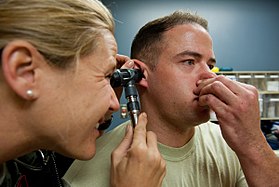Valsalva manoeuvres
| Valsalva maneuver | |
|---|---|

A man performs the Valsalva maneuver while his ear is examined with an otoscope.
|
The Valsalva maneuver or Valsalva manoeuvre is performed by moderately forceful attempted exhalation against a closed airway, usually done by closing one's mouth, pinching one's nose shut while pressing out as if blowing up a balloon. Variations of the maneuver can be used either in medical examination as a test of cardiac function and autonomic nervous control of the heart, or to clear the ears and sinuses (that is, to equalize pressure between them) when ambient pressure changes, as in diving, hyperbaric oxygen therapy, or air travel.
The technique is named after Antonio Maria Valsalva, a seventeenth-century physician and anatomist from Bologna whose principal scientific interest was the human ear. He described the Eustachian tube and the maneuver to test its patency (openness). He also described the use of this maneuver to expel pus from the middle ear.
A modified version is done by expiring against a closed glottis. This will elicit the cardiovascular responses described below but will not force air into the Eustachian tubes.
The normal physiological response consists of four phases.
Deviation from this response pattern signifies either abnormal heart function or abnormal autonomic nervous control of the heart. Valsalva is also used by dentists following extraction of a maxillary molar tooth. The maneuver is performed to determine if a or antral communication exists.
When rapid ambient pressure increase occurs as in diving or aircraft descent, this pressure tends to hold the Eustachian tubes closed, preventing pressure equalization across the ear drum, with painful results. To avoid this painful situation, divers, caisson workers and aircrew attempt to open the Eustachian tubes by swallowing, which tends to open the tubes, allowing the ear to equalize itself.
...
Wikipedia
